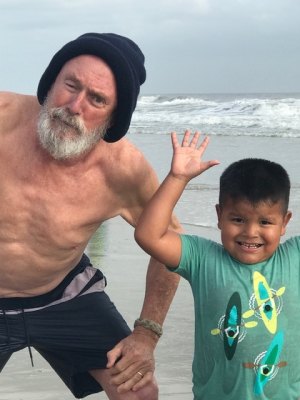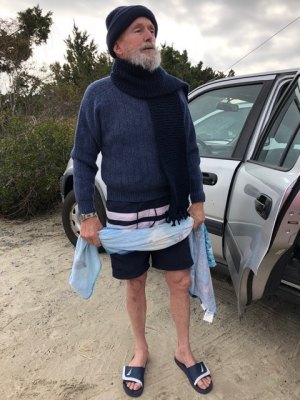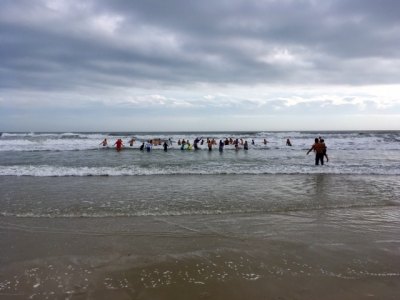Plunge into the New Year!
If you start the new year off by diving into the surf with 39 other brave souls of all ages what can’t you do in the coming twelve months? The annual New Year’s Day Ocracoke Polar Plunge was held at 2 p.m. today under better-than-usual weather conditions. The wind was light, there was intermittent sunshine, the air temperature was 66 degrees and I heard someone say the water temperature was 60. Not bad at all for January!
Both of my daughters were game for the plunge and when they generously offered me an old age pass I was having none of it. Can’t let these kids think you’re getting too old for stuff or who knows where it’ll end! As it turned out I was the senior participant with 70 years on the youngest, Gael Guerrero-Perez a spritely 4-year-old.

The knitted hat I wore in did nothing at all to keep my scalp dry but it did an admirable job of shielding my stitches and bandage from view. (I had skin cancer surgery four days ago – not sure what the good doctor would think of my swim). And, of course, having been a Boy Scout many many years ago, I didn’t want to come unprepared so I brought a small flask along to keep the old circulation going.
All in all it was not an unpleasant experience and I felt pretty certain most of the younger set would have stayed in the water for hours if their parents hadn’t been ready to leave.
I can’t think of going into the ocean in the winter without being reminded of the wooden ships and iron men of an earlier time – specifically the U.S. Life-Saving Service. To me the most remarkable story of their many rescues was that of the 3-masted schooner Sarah D.J. Rawson on February 9-10, 1905. Keeper William H. Gaskill and his eight surfmen of the Cape Lookout Station were all in bed with the flu, getting up only as needed to fulfill watch duty.
It was a cold, blustery and foggy day and, a little past noon, Keeper Gaskill caught sight of a mast in a temporary break in the fog. A three-masted schooner with a deck load of lumber had grounded on Lookout Shoal nine miles out. All nine men boarded their surf boat and rowed out to the wreck but were unable to get close due to the violent surf and the loose lumber floating around the wreck. One of the seven crewmen of the schooner had already been swept to his death. The lifesavers anchored their vessel downwind of the wreck in case anyone else should wash overboard.
In the morning when the wind shifted and the tide turned they were able to approach close enough to heave a line to the wreck and, one by one, haul the six crewmen through the water to their lifeboat where the life savers (sleepless and sick with flu) shed their oilskins to clothe the victims before rowing them nine miles back to the station.

I suspect those guys would have been delighted with the balmy beach day we had. Happy New Year!
For further reading about the U.S. Lifesaving Service, check out the list of resources on this blog post from Philip Howard.




